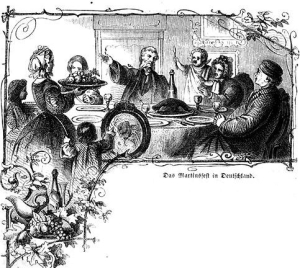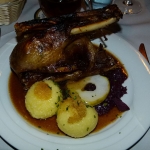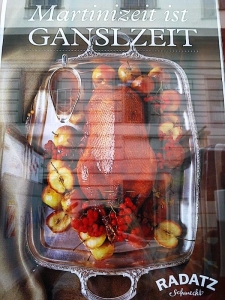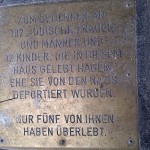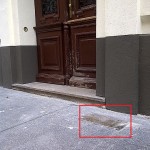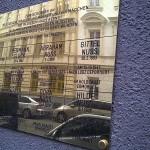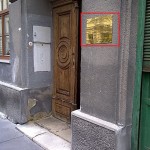Your Goose is Cooked – or roasted and served with Red Kraut, Dumplings and Zweigelt
November 11, St. Martin’s Day (Martinitag) with goose served the week before and after all over Austria
If you’ve been to Austria in early to mid-November and noticed all the laid-back turkeys gobbling around their wide-eyed heads-in-the-pile-of-leave goose feathered friends, you may have asked yourself, “What’s up with that?” It’s November and the turkeys are chilled but the geese look baked? Or roasted rather. Yep.
Here in Yodel land the geese have a lot to ruffle their feathers about come November because the week before and after November 11 is all about getting some geese. On November 11, Austrians celebrate Martinitag. And no, stop thinking of trips to the cocktail bar all the time. It’s not that kind of Martini, Mr. Bond. It is Martini as in St. Martin’s Day. So get a bit saintly now. And just like we will traditionally eat ourselves some light and dark turkey meat for Thanksgiving, the Austrians are digging into some red Kraut and goose meat for St. Martini.
The tradition of eating a goose on Martini Day might be traced back to Martini Day also being the Hauptzinstag (Main Interest Day – interest as in finance not in, I’m heading to the dance floor, got any interest?). Anyway, the Hauptzinstag was the first day of the new business year and also the day that the farmhands got paid, leasing contracts signed, taxes settled, and servants could change their employers. In order to keep down the costs associated with feeding the livestock throughout the long cold hard winters, a lot of farm animals were slaughtered. Including – yes, my feathered friends, sorry to say, including geese. So long story short – a good excuse to fill up the bellies before advent fasting rolled around.
What’s up with the lanterns, kids?
Another, younger tradition on Martini Day, is for children to make colorful lanterns out of paper and cardboard in kindergarten class. Then on the eve of St. Martin’s Day (November 11) the kiddies proudly carry their self-made pyro masterpieces in a procession around the local church while singing sweet little lantern carols and reciting St. Martin poems to all the goo-goo eyed Mas and Paps worried about the flames the little ones are toting dangerously clothes to the winter coats and scarves of their lantern carrying kindergarten peers. So if you see a bunch kids playing with matches, carrying lanterns and singing somber songs, don’t get worried that the apocalypse might be coming and you missed the memo.
Who was this St. Martin Fellow anyway?
St. Martin’s Day is a celebration of Martin of Tours and the date coincides with his burial date on November 11, 397. Martin was apparently a Roman soldier who, seeing a beggar freezing in the middle of a snowstorm, cut his own cloak in half to share with the beggar. That night Martin had a dream that Jesus was wearing the other half of his cloak and an angel praised the soldier who had never been baptized for his benevolent act of charity.
But why the goose? There are many legends why of course. Here are some of my favorites: The townsfolk all wanted Martin to be a bishop but humble Martin didn’t feel worthy of the honor and hid in a goose stall and the cackling disturbed feathered residents betrayed their intruder’s whereabouts with their yattering protests. A second legend is that a gaggle of geese (yep, that’s what a legion of geese are called – a gaggle – aren’t you impressed? Learned something today, didn’t ya?) interrupted Martin during his sermon by marching right into the church right in the middle of the hallelujahs and the serious townsfolk served them up their due, right on the dinner table with Kraut and Knödel.
What’s For Dinner?
Always thinking about your stomach, aren’t you. Well, almost always.
A typical Martini Dinner will include roasted goose served with red kraut (which I adore and it you’ve never tried, you must!) and some stuffing-kind-of-yummy-dumplings. And wine. Don’t forget the wine!
Random Facts about Martini:
Martini Day often marks for Austrian farmers the day that their animals will no longer be “ausgetrieben” (put out to pasture) and will be “eingestallt” (kept in the stalls).
Goose Words 101: Martinsgansessen (Martin Goose Meal), Martinigans (Martin Goose), Martinigansl (Cute little Martin Goose), Rotkraut (red Kraut), Serviettenknödel (Yummy dumplings), Wein (wine – don’t forget the wine for Pete Martin’s sake!), Gänseschar (goose gaggle – you didn’t forget already, did you?)
Where to Get Your Goose:
Radatz: for a goose on the run, fast food style – inexpensive, quick, but still scrumptuous
Heuriger: really, if you’re in Vienna, there’s no excuse not to call up a Heuriger of your choice and make goose meal reservations for you and your friends (unless they’re booked). I did (@ Schübl Auer and the goose was great) just make sure you specify that you’re coming for the goose and don’t do what I did and forget to specify if you prefer non-smoking. 
Other places to get your goose:
Lyrics to the Martini Song
| Ich geh mit meiner Laterne und meine Laterne mit mir, dort oben da leuchten die Sterne, da unten leuchten wir. Mein Licht geht aus, wir gehen nach Haus, rabimmel-rabammel-rabumm! | I walk with my little lantern, my little lantern walks with me. Above the stars shine brightly, done here we shine brightly too. My light goes out, I go home now, ra bimmel, ra bammel ra bumm! |

